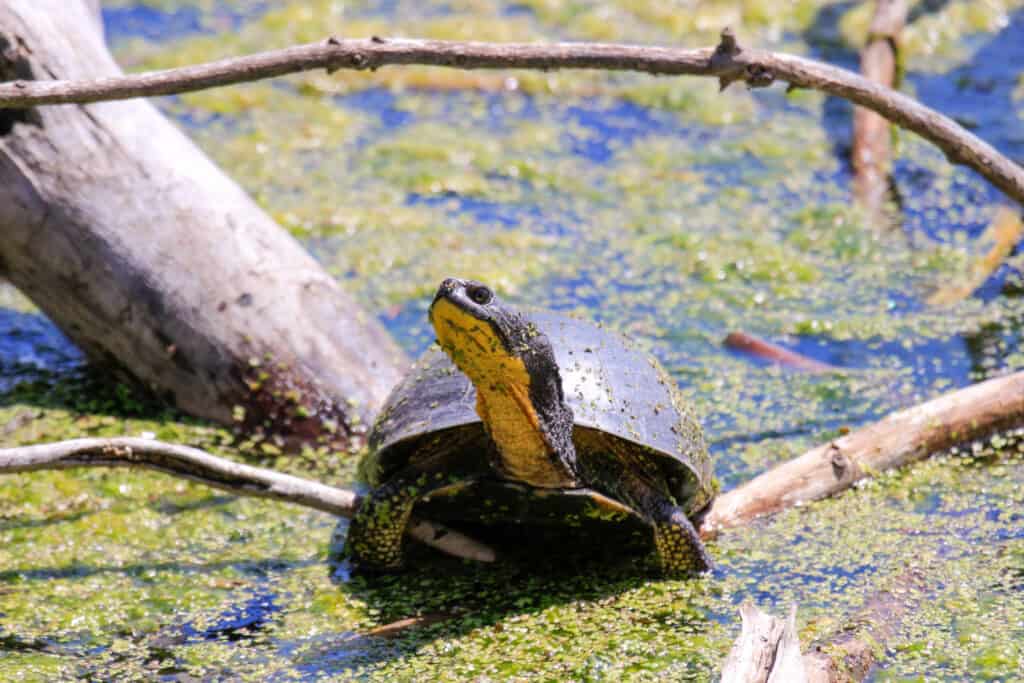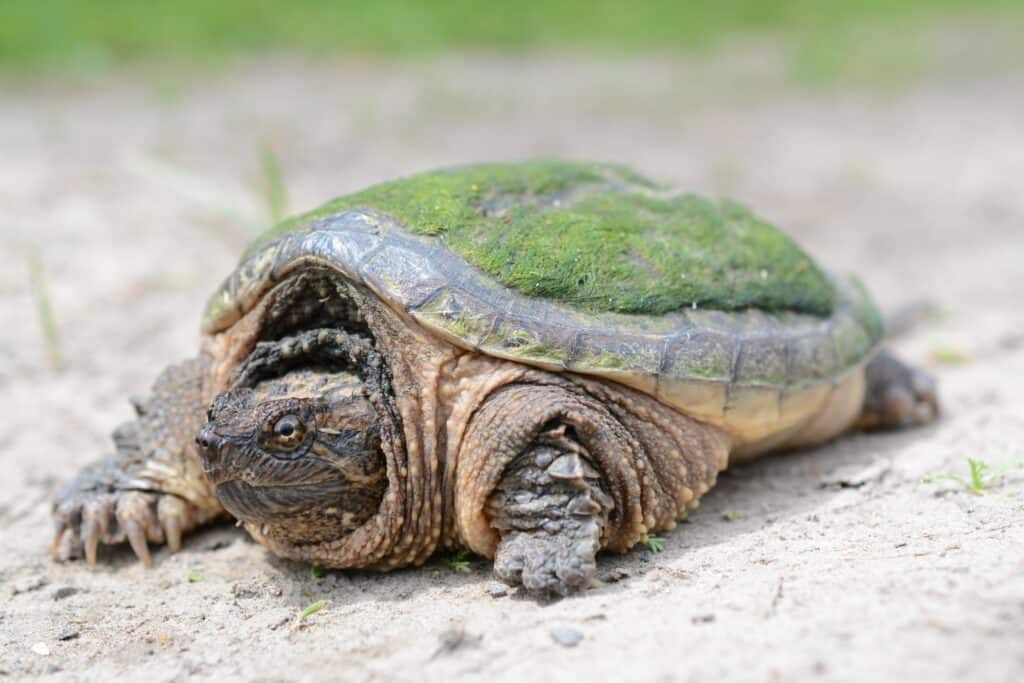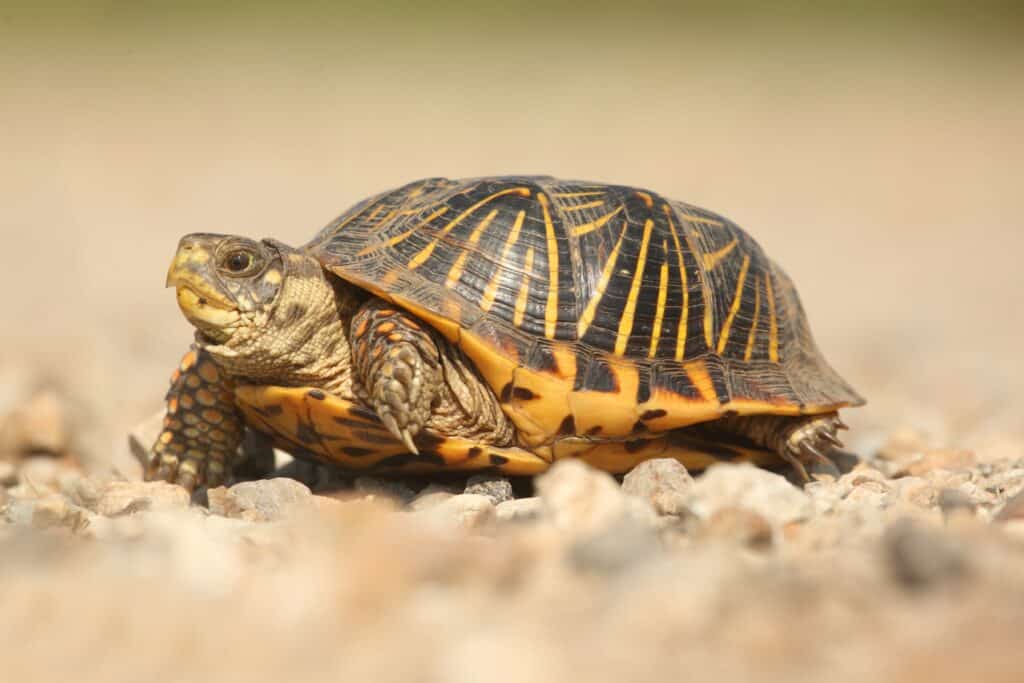Indiana is home to around 15 different native species of turtles. From tiny mud turtles to colorful pond sliders and even massive snapping turtles, the Hoosier State’s shelled reptiles vary wildly in size, shape, color, diet, and more! Below, we’ll take a look at eight of Indiana’s most amazing, fascinating, and downright bizarre turtles you need to know about.
1. Blanding’s Turtle (Emydoidea blandingii)

Blanding’s turtle has a hinged plastron.
©iStock.com/mynewturtle
The Blanding’s turtle gets both its common name and scientific name from American naturalist Dr. William Blanding. This unique turtle is sadly currently endangered throughout most of its native range, including much of Indiana, primarily due to habitat loss and fragmentation. Despite this, it is remarkably hardy, with many individuals commonly living well into their eighties and even nineties!
One of the Blanding’s turtle’s most distinctive traits is its bright, sunny yellow chin and throat, which strongly contrasts the rest of its greenish-brown skin. It has a fairly tall, dome-shaped carapace that is typically dark brown with tiny yellowish speckles or flecks. On average, it reaches 7 to 10 inches in length.
Oddly, similar to the box turtle, it has a hinged plastron (the bottom portion of its shell). However, the hinges on its shell do not close nearly as tightly as those of box turtles. As a result, many herpetologists have dubbed it a “semi-box turtle,” though the two species aren’t closely related.
2. Red-Eared Slider (Trachemys scripta elegans)

Red eared sliders are invasive to the United States.
©effective stock photos/Shutterstock.com
The red-eared slider has gained notoriety for being one of the world’s most invasive animal species–to the point that it has outcompeted and pushed many native turtle species out of their habitats across the United States. This turtle’s actual native range encompasses much of the lower Midwest, including all but the northern border of Indiana.
This popular pond turtle is easy to identify thanks to the bright red splotches on either side of its head, from which it gets its common name. The rest of its skin is a deep green with lots of thin yellow stripes. The turtle’s carapace shifts in color with age from dark green as a hatchling to dark brown as an adult. It can reach more than 15 inches in length, but most individuals max out at around 6 to 10 inches long.
Despite being the most commonly traded turtle species in the world, the exotic pet trade has contributed significantly to the red-eared slider’s invasive status. Today, many US states have restrictions on the sale of this species.
3. Eastern Box Turtle (Terrapene carolina carolina)

Eastern box turtles can live up to four decades.
©iStock.com/Alan Doucet
The eastern box turtle is one of six subspecies of the common box turtle. Notably, it’s one of the most vibrant and colorful box turtle subspecies. Both its skin and shell are handsomely mottled yellow, orange, and brown. Also worth noting is its impressively widespread geographic range that covers much of the eastern half of the United States.
Although the eastern box turtle superficially resembles a tortoise, it actually falls under the Emydidae family of pond turtles. This makes it fairly closely related to pond sliders, spotted turtles, and wood turtles. Being mostly terrestrial in nature, its feet are semi-webbed, but only at the base of the foot, unlike the fully webbed feet of its more aquatic cousins.
The box turtle’s most recognizable trait, however, is its hinged plastron. The bottom of its shell has a hinge at the front and back. This allows the turtle to tightly shut its head and limbs inside the shell like a protective box, giving it a valuable defense mechanism against potential predators.
4. Common Snapping Turtle (Chelydra serpentina)

The common snapping turtle is shy around humans.
©Trevor Meunier/Shutterstock.com
As one of North America’s largest freshwater turtles, the common snapping turtle has a commanding presence. Its massive carapace is thick and rugged, while its plastron is significantly reduced in size to give its muscular legs a wide range of mobility compared to most other freshwater turtle species. Its beak is razor-sharp and supported by wide, strong jaws, giving it a devastating bite. What’s more, the turtle’s neck is deceptively long and flexible.
Unsurprisingly, the common snapping turtle is incredibly hardy and has very few natural predators. Its geographic range covers much of the United States and even extends up into southern Canada. On average, it reaches around 10 to 18 inches long, with some individuals exceeding 20 inches in length. With their bulky, tank-like build, it is common for snapping turtles to weigh anywhere from 10 to 40 pounds!
Due to its intimidating appearance, the common snapping turtle has gained a fearsome reputation. It’s also one of Indiana’s largest turtles, second to only the alligator snapping turtle. In reality, though, it is quite shy around humans, usually preferring to flee rather than strike unless provoked.
5. Alligator Snapping Turtle (Macrochelys temminckii)

Alligator snapping turtles are the largest turtles in Indiana.
©Sista Vongjintanaruks/Shutterstock.com
Indiana’s largest turtle is the alligator snapping turtle. It is also one of the heaviest freshwater turtles on the planet, commonly weighing anywhere from 20 to well over 150 pounds. Along with the common snapping turtle, it is one of the only surviving members of the Chelydridae family of snapping turtles.
This unique reptile has perhaps an even more intimidating appearance than the common snapping turtle, in part thanks to its heavily ridged, jagged carapace, enormous jaws, and strong, clawed feet. Like the common snapping turtle, the underside of its shell is reduced in size compared to most turtle species. This gives its powerful limbs a wide range of mobility, making it quite speedy on land and in the water.
Incredibly, the alligator snapping turtle is believed to have a lifespan exceeding 150 years, as it ages slowly and is extremely weather-hardy. However, its true lifespan in the wild isn’t very well understood. Sadly, it is currently endangered and protected by law in Indiana as well as a handful of other US states. This is primarily due to habitat loss, illegal collection for the exotic pet trade, and the fact that it is often hunted and harvested for its meat.
6. Ornate Box Turtle (Terrapene ornata ornata)

Ornate box turtles are sexually dimorphic,
©Steve Byland/Shutterstock.com
Another one of Indiana’s resident box turtle species is the ornate box turtle. While it has a similar appearance to the eastern box turtle overall, the yellow patterning on its carapace tends to look more like thin lines or stripes rather than large, uneven splotches. It’s also slightly smaller than the eastern box turtle at just 4 to 6 inches long on average.
Like most box turtles, the ornate variety is highly sexually dimorphic. This means males and females are visually distinct from one another in several key ways. For starters, male ornate box turtles typically have bright red or orange eyes, while the females’ eyes are dark brown. Additionally, males have longer, thicker tails than females, more reddish markings on their limbs, and long, curled claws on their back feet.
Currently, the ornate box turtle is threatened in Indiana, where it is now protected by law. Its threatened status is mainly due to habitat loss and the illegal collection of individuals for the exotic pet trade.
7. Northern Map Turtle (Graptemys geographica)

The northern map turtle is endemic to North America.
©iStock.com/PaulReevesPhotography
Similar to most other map turtle species, the northern map turtle gets part of its common name from the thin, webbing-like lines crisscrossing its dark brown carapace. These distinct markings are usually yellowish or tan in color and look just like contour lines on a map!
As a highly sexually dimorphic species, the northern map turtle’s size varies significantly depending on its sex. While males average just 4 to 6 inches long, females of the species are much longer and larger at 7 to 10 inches long. Male northern map turtles also have longer, thicker tails and narrower heads when compared to females.
The northern map turtle’s geographic range covers most of Indiana, much of the upper Midwest, and parts of the US northeast coast. It can inhabit a variety of habitats, though it prefers lakes, rivers, and ponds with lots of basking spots. It commonly basks on upturned logs, branches, and rocks.
8. Spiny Softshell Turtle (Apalone spinifera)

Spiny softshell turtles have long, thin, and flexible snouts.
©iStock.com/Brian Reinke
We’ll cap off this list with another one of Indiana’s largest freshwater turtles: the striking and unusual spiny softshell. There are more than 20 different kinds of softshell turtles within the Trionychidae family, but only three of them live in North America: the spiny, smooth, and Florida varieties. True to its name, the spiny softshell is unique for the small, cone-shaped spines jutting out from the edges of its carapace.
The spiny softshell can range from 7 to 20 inches in length, with males being much smaller than females. Both sexes share a pancake-flat, smooth shell that completely lacks individual scales or scutes. The carapace is typically tan to dark brown in color, often with tiny dark brown spots throughout. This highly aquatic turtle’s snout is long, thin, and flexible, allowing it to breathe even while its entire body is submerged in water.
Interestingly, the spiny softshell is North America’s most widespread and abundant member of the Trionychidae family. Its geographic range covers most of the eastern half of the United States and extends northward into southern Canada.
Up Next:
The photo featured at the top of this post is © Steve Byland/Shutterstock.com
Thank you for reading! Have some feedback for us? Contact the AZ Animals editorial team.






